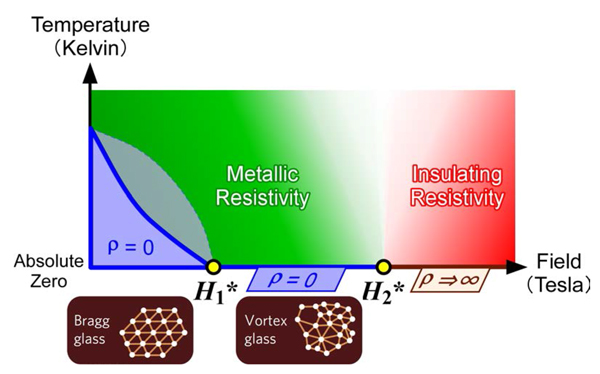Researchers at Tokyo Institute of Technology uncover the complexities of quantum phase fluctuations during the superconductor-insulator transition in high-temperature superconductors.
The superconductor-insulator transition (SIT) in high-temperature copper-oxide (‘cuprate’) superconductors is commonly triggered by the application of a magnetic field. However, due to the complexities of superconductivity, many questions are still to be answered about the exact process which underpins the SIT and the associated quantum phases the material undergoes.
Scientists had thought that high-temperature superconductors had a single quantum critical point at which the material switches from a superconductor to an insulator when a particular strength of magnetic field was applied. Now, an international team of researchers from the USA and Japan, including Takao Sasagawa at Tokyo Institute of Technology, have uncovered a two-stage transition in lanthanum-strontium-copper-oxide high-temperature superconductors (LSCOs), leading to the first complex phase diagram of the behavior of LSCOs.
“The delicate interplay of thermal fluctuations, quantum fluctuations and disorder leads to a complex H-T [magnetic field-temperature] phase diagram of vortex matter,” the authors state in their paper published in Nature Physics.
The researchers measured electrical resistivity of the material in magnetic fields up to 18 T at various temperatures down to 0.09 K, revealing the complete picture of the SIT. They deliberately used a variety of LSCOs that had been created using different techniques, so as to separate out the effects of sample preparation from more general superconductive behavior.
Sasagawa's team discovered that the LSCOs showed a two-stage magnetic-field-induced transition at T = 0 K before they become insulators. Firstly, the material forms a superconducting vortex lattice state known as 'Bragg glass'. In this phase, the material shows zero resistivity at finite temperature. After a first critical point is reached it passes into a disordered superconducting phase, or ‘Vortex glass’, wherein the arrangement of vortices becomes amorphous. In this phase, zero resistivity is only realized at absolute zero. After a second critical point is reached, superconductivity is lost and the LSCOs become insulating.
The researchers conclude; “Our results provide important insight into the interplay of vortex line physics and quantum criticality in high-temperature superconductors, bridging the gap between their behavior in the high-T ‘classical’ region and the less-explored low-T ‘quantum’ region.”
Background
Superconductivity
TSuperconductors are materials that can maintain a perpetual electrical current, without the need for a power source, at certain temperatures. It was thought that only super-cooled materials (at temperatures below 30 K, or 243 C) were capable of superconductivity, but copper-oxide ‘cuprate’ and pnictide (iron and arsenic) superconductors belong in the class of high-temperature superconductors which work at temperatures as high as 138 K (-135 C). A main aim of current research is to explain the mechanism of high-temperature superconductivity and to find a superconductor that will work at room temperature.
Type II superconductors and vortex states
TType II superconductors have a so-called mixed or ‘vortex’ state under a magnetic field - internal ‘vortices’ of superconducting currents are generated which surround cores of the normal state of material (metallic state for conventional superconductors) and create quantized magnetic flux lines. The movements of the vortices can generate tiny amounts of resistance, meaning the superconductivity is not perfect. The vortices can be ‘pinned’ or frozen in place on the bulk material in order to make a zero-resistance superconducting state. In conventional superconductors, superconductivity is completely lost at a certain magnetic field where the normal-state cores of vortices are overlapped each other. In this case, a single-stage superconductor‘metal’ transition takes place at absolute zero under magnetic fields. On the other hand, the behavior of high-temperature superconductors is unusual; the transition appears to be from a superconductor to an ‘insulator’, and a clear observation over the entire H-T phase diagram including absolute zero has yet to be done.
Not just one ‘quantum critical point’
The work by researchers at Florida State University (led by Professor Popovic) and Tokyo Institute of Technology (led by Professor Sasagawa) proves for the first time that LSCO high-temperature superconductors go through two quantum critical points before becoming insulators, due to the subtle effects of temperature fluctuations and magnetic field disruptions on the vortex state. Their research could improve understanding of high-temperature superconductivity under magnetic fields and provide an important insight into the application of high-temperature superconductors.
Reference
X. Shi, Ping V. Lin, T. Sasagawa, V. Dobrosavljevic and D. Popovic. “Two-stage magnetic-field-tuned superconductor-insulator transition in underdoped La2-xSrxCuO4.” Nature Physics, Published Online (4 May 2014);doi:10.1038/nphys2961

Research at Tokyo Institute of Technology and Florida State University has uncovered the whole picture of the H-T phase diagram and the complex interplay between vortex physics and quantum critical behaviour in lanthanum-strontium-copper-oxide high-temperature superconductors.
. Any information published on this site will be valid in relation to Science Tokyo.



